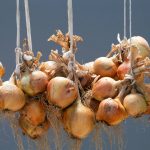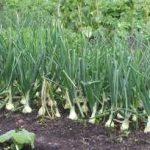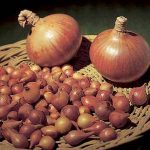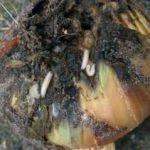How to Grow Onions – A Guide to Growing Onions
 Onions- Allium cepa
Onions- Allium cepa
Onions are the most valuable, yet underrated, vegetable partly due to the bland taste of shop varieties. Home gardeners can choose from a wide variety of onions to suit their taste, from very mild to eye-watering strong. You can also choose particular colours, size, and onions for specific purposes. And a tasty onion is also a healthy choice with Vitamin C, B6, Folic Acid, as well as a good source of fibre.
The onion’s famous potency is due to the sulphur content as well as how you grow your onions such as the type of soil you have, what hummus you incorporate, water content, weather conditions, and the type of feed or fertilizers you use.
Like all plants, onions need potash; the more potash they have available the less sulphur they absorb. Using low potash fertilisers will result in smaller, but stronger tasting onions.
Recommended Varieties of Onions
There are many varieties to choose from depending on the potency you wish, the size desired from pickling to big slicers, colour, and day length.
A popular storage set onion is Sturon and favourite sweet eating onions include Ailsa Craig and Walla Walla.
Onion Pests and Problems
The onion root fly can be a problem and fine netting can control this. Slugs can also do some surface damage and eelworms can do significant bulb damage.
Another problem appearing in wet years is onion rot that can totally wipe out a crop and the spores remain in the soil for another 5 or more years.
Onion neck rot is a fluffy grey growth on onion necks.
Sowing and Growing
Main bulb onions are either grown from seeds or sets, which are simply small bulbs. Spring onions or scallions are always grown from seed. Beginners find sets are easier because the onions have a head start even if planted late, are more disease resistant and crop better in poorer soils, and they tend to avoid the onion fly a bit better.
Main crop onion seeds are usually started indoors around February. There is considerable more variety in seeds which are less prone to bolting and usually store better. Start these in modules or flats. Note that onion seeds have a short shelf life so it’s worth purchasing smaller seed packages. When planting time approaches, harden off onion seedlings before planting out.
In the damper UK climate, it’s best to rotate onion growing areas every year to avoid onion rot. Recently cultivated areas from grass will likely contain eelworms.
Bulbing onions are day-length sensitive, and most European long-day onions bulb once 15 or more hours of daylight occur. Short-day onions, often called Japanese onions, can be planted in fall when 9-10 hours of sunlight are available. The short-day type do not store well but do fill the gap until main crop onions arrive a bit later. Choose what suits your area and needs.
Planting out soil can be light to medium density, must be well-drained, and have some rotted manure or compost dug in the previous autumn but not be overly rich. Potash can be added as ashes or in fertilizers.
Because onions are a cool weather plant, hot temperatures or other stress conditions like irregular watering in dry times can cause the plant to bolt (go to seed). The bulbing tip can be snapped off and the onion grown on, but it will not store well so should be marked for use once harvested.
One caveat for onion growers is to not overwater them. They are shallow-rooted and once established they do not need much water. They also do not compete well with weeds at any time, particularly when young. In years of heavy rainfall, they appreciate a clear, protective cover to keep soil a little drier.
Harvesting, Storage and Eating
Onions can be harvested at any time as needed, but for storage expect to wait about 12 – 18 weeks depending on variety size. At this time, when the onion tops start to fall over, it’s time to gently push all the leaves downward at the neck and leave the plants to ‘die off’ for about 2 weeks. Once most of the leaves are brown or dried out, the bulbs can be pulled out and placed on screens or slatted flats to dry out for a further few days, even weeks. They cannot be safely stored until all the tops are crispy brown and a dried outer skin has formed. At that time the dried roots can be trimmed, as can the dried tops. Thick-necked onions will not store as long as thin-necked ones.
Once properly cured (dried), onions need air space to stay dry so shallow slatted boxes are idea, as are slim nets or simply roped into strings. Store in a cool, well-ventilated darker space such as a shed that does not freeze.
Onions can be used in any form in most dishes – cooked or raw. The acidity of onions helps soften tough meats which is why they’re so popular in meat dishes. The best way to avoid teary eyes when cutting onions is to cut them either under running water or in a basin filled with water.
Please note that onions are toxic to dogs, cats and other small animals. The severe toxicity is caused by the sulfoxides present in raw and cooked onions which they cannot digest, and this leads to anaemia that can damage red blood cells. Avoid feeding them pizzas, casseroles, onion rings, and other foods containing onions.
Further Information on Onions
More Information on Growing Onions
Harvesting and Storing Onions & Shallots
How to Grow Onions from Seed - Allium Cepa
How to Grow Onions from Sets - Allium Cepa
Onion Pests, Diseases & Problems
Growing Onions for Show
- Growing Onions for Show – Selecting & Propagating Onions
- Growing Onions for Show – 250 gram Exhibition Onions
- Growing Onions for Show – Starting Large Onions from Seed
- Growing Onions for Show – Cultivating Exhibition Onions







